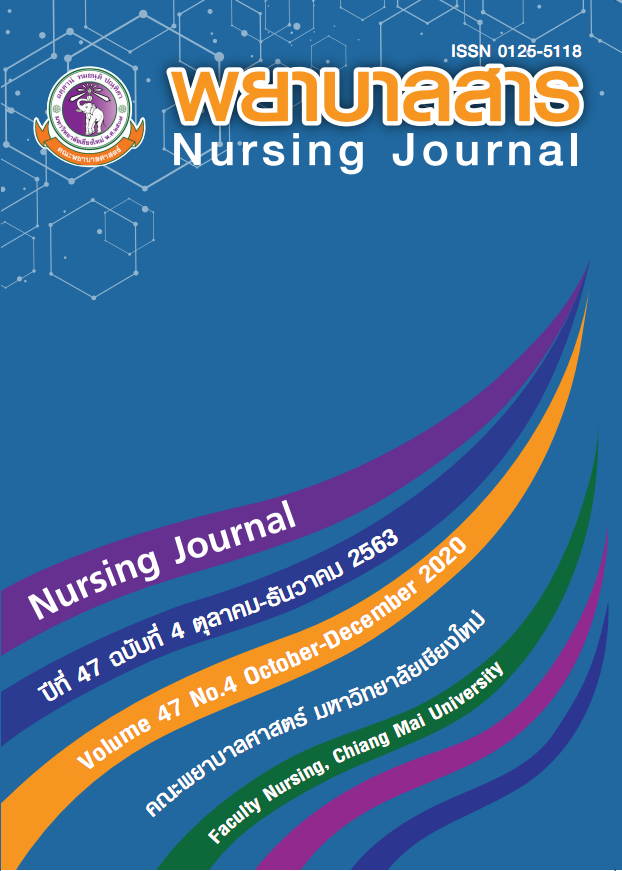ประสิทธิผลของการใช้แนวปฏิบัติทางคลินิกเพื่อส่งเสริมการนอนหลับในผู้ป่วยวิกฤต
คำสำคัญ:
การส่งเสริมการนอนหลับ, ผู้ป่วยวิกฤต, แนวปฏิบัติทางคลินิก, คุณภาพการนอนหลับ, การรบกวนการนอนหลับบทคัดย่อ
ปัญหาการนอนหลับส่งผลกระทบต่อผู้ป่วยวิกฤตเป็นอย่างมาก ทีมบุคลากรทางสุขภาพ
ในหอผู้ป่วยวิกฤตควรให้การส่งเสริมการนอนหลับของผู้ป่วยเหล่านี้ การวิจัยเชิงพัฒนาและปฏิบัติการ
ในครั้งนี้มีวัตถุประสงค์เพื่อพัฒนาแนวปฏิบัติทางคลินิกสำหรับส่งเสริมการนอนหลับในผู้ป่วยวิกฤต
และศึกษาประสิทธิผลของการใช้แนวปฏิบัติทางคลินิกสำหรับการส่งเสริมการนอนหลับในผู้ป่วยวิกฤต ศูนย์ศรีพัฒน์คณะแพทยศาสตร์ มหาวิทยาลัยเชียงใหม่ โดยใช้กรอบแนวคิดการพัฒนาและการใช้แนวปฏิบัติของสภาวิจัยทางการแพทย์และสุขภาพแห่งชาติ ประเทศออสเตรเลีย (NHMRC, 1999)
กลุ่มตัวอย่างประกอบด้วย 1) ผู้ให้บริการทางสุขภาพซึ่งเป็นผู้ใช้แนวปฏิบัติทางคลินิกจำนวน 47 คนและ 2) ผู้ป่วยที่เข้ารับการรักษาในหอผู้ป่วยวิกฤตกลุ่มก่อนการใช้และกลุ่มที่มีการใช้แนวปฏิบัติทางคลินิก จำนวน 33 และ 55 คน ตามลำดับ เครื่องมือที่ใช้ในการรวบรวมข้อมูลประกอบด้วย
1) แบบสำรวจความคิดเห็นเกี่ยวกับการใช้แนวปฏิบัติทางคลินิก และ 2) แบบรวบรวมผลลัพธ์ของการส่งเสริมการนอนหลับในผู้ป่วยวิกฤต วิเคราะห์ข้อมูลโดยใช้สถิติเชิงพรรณนา
ผลการวิจัยพบว่า
- แนวปฏิบัติทางคลินิกสำหรับส่งเสริมการนอนหลับในผู้ป่วยวิกฤต ศูนย์ศรีพัฒน์
คณะแพทยศาสตร์ มหาวิทยาลัยเชียงใหม่ ประกอบด้วย สาระสำคัญ 6 หมวด ได้แก่ 1) การพิทักษ์สิทธิของผู้ป่วย และจริยธรรม 2) การประเมินการนอนหลับ 3) การให้ความรู้เกี่ยวกับการนอนหลับ
และวิธีการ การส่งเสริมการนอนหลับแก่บุคลากรที่เกี่ยวข้อง 4) การจัดการเพื่อส่งเสริมการนอนหลับ
5) การติดตามการส่งเสริมการนอนหลับอย่างต่อเนื่องและการบันทึก และ 6) การพัฒนาคุณภาพบริการ - ผู้ใช้แนวปฏิบัติทางคลินิก ร้อยละ 82.4 ถึง 94.1 เห็นด้วยในระดับ “มาก”
ต่อความเป็นไปได้ในการนำแนวปฏิบัติทางคลินิกไปใช้ - กลุ่มตัวอย่างที่มีการใช้แนวปฏิบัติทางคลินิกเพื่อส่งเสริมการนอนหลับในผู้ป่วยวิกฤต
มีคะแนนเฉลี่ยคุณภาพการนอนหลับสูงกว่ากลุ่มก่อนการใช้แนวปฏิบัติทางคลินิกในคืนที่ 1 ( = 67.3, S.D. = 24.28 และ = 57.2, S.D. = 23.53) และคืนที่ 2 ( = 71.43, S.D. = 21.88 และ = 45.9, S.D. = 26.99)
เอกสารอ้างอิง
Always, A., Halm, M. A., Shilhanek, M., & Pierre, J. (2013). Do earplugs and eye masks affect Sleep and delirium outcomes in the critically ill?. American Journal of Critical Care, 22(4), 357-360. doi:10.4037/ajcc2013545
Burn, N., & Grove, S. K. (2009). The practice of nursing research: Appraisal, synthesis, and generation of evidence (6th ed.). Missouri: Saunders Elsevier.
Daneshmandi, M., Neiseh, F., SadeghiShermeh, M., & Ebadi, A. (2012). Effect of eye mask on sleep quality in patients with acute coronary syndrome. Journal of Caring Sciences, 1(3), 135-143. doi:10.5681/jcs.2012.020
DeKeyser, F. (2003). Psychoneuroimmunology in critically ill patients. Advance Practice in Acute and Critical Care, 14(1), 25-32.
Diekelmann, S., Wilhelm, I., & Born, J. (2009). The what and whens of sleep-dependent memory consolidation. Sleep Medicine Reviews, 13(5), 309-321. doi:10.1016/j.smrv.2008.08.002
Duong-Coburn, N. K. (2013). A Systematic Review of Sleep Quality and Sleep Promotion in The Intensive Care Unit. Retrieved from https://csusmdspace.calstate.edu/bitstream/handle/10211.8/535/DuongCoburnNhung_Fall2013.pdf?sequence=1
Drouot, X., Cabello, B., d’Ortho, M. P., & Brochard, L. (2008). Sleep in the intensive care Unit. Sleep Medicine Reviews, 12(5), 391-403. doi:10.1016/j.smrv.2007.11.004
Elliott, R., McKinley, S., & Cistulli, P. (2011). The quality and duration of sleep in the intensive care setting: An integrative review. International Journal of Nursing Studies, 48(3), 384-400. doi:10.1016/j.ijnurstu.2010.11.006
Friese, R. S. (2008). Sleep and recovery from critical illness and injury: A review of theory, current practice, and future directions. Critical Care Medicine, 36(3), 697-705. doi:10.1097/ CCM.0B013E3181643F29
Honkus, V. L. (2003). Sleep Deprivation in Critical Care Units. Critical Care Nursing Quarterly, 26(3), 179-191.
Joint Commision on Acreditation of Healthcare Organization. (2001). Pain management: A systems approach to improveing quality and safety. Retrieved from http://www.jcrinc.com/pain-management-a-systems-approach-to-improving-quality-and-safety/
Kamdar, B. B., Needham, D. M., & Collop, N. A. (2012). Sleep deprivation in critical illness: Its role in physical and psychological recovery. Journal of Intensive Care Med, 27(2), 97-111. doi:10.1177/0885066610394322
Liao, W. C., Huang, C. Y., Huang, T. Y., & Hwang, S. L. (2011). A systematic review of sleep patterns and factors that dictrub sleep after heart surgery. The Journal of Nursing Research, 19(4), 275-288. doi:10.1097/JNR.0b013e318236cf68
Linck, V. M., da Silva, A. L., Figueiro, M., Caramao, E. B., Moreo, P. R. H., & Elisabetsky, E. (2009). Effects of inhaled linalool in anxiety, social interaction and aggressive behavior in mice. Phytomedicine, 17(8-9), 679-683. doi:10.1016/j.phymed.2009.10.002
National Health and Medical Research Council. (1999). A guideline to the development, implementation, and evaluation of clinical practice guidelines. Retrieved from http://www. nhmrc.gov.au/ publications/_files/ cp30.pdf
National Health and Medical Research Council. (2000). How to put the evidence into practice: Implementation and dissemination strategies. Retrieved fromhttp://www.nhmrc.gov.au/ publications/_files/cp 71.pdf
Orton, D. I., & Gruzelier, J. H. (1989). Adverse changes in mood and cognitive performance of house officers after night duty. British Medicine Journal, 298(6665), 21-33.
Ozsancak, A., D'Ambrosio, C., Garpestad, E., Schumaker, G., & Hill, N. S. (2008). Sleep and Mechanical Ventilation. Critical Care Clinics, 24(3), 517-531. doi:10.1016/j.ccc. 2008.03.002
Pandharipande, P., & Ely, E. W. (2006). Sedative and analgesic medications: Risk factors for delirium and sleep disturbances in the critically ill. Critical Care Clinics, 22(2), 313-327. doi:10.1016/j.ccc.2006.02.010
Parthasarathy, S., & Tobin, M. J. (2004). Sleep in the intensive care unit. Intensive Care Medicine, 30(2), 197-206.
Richards, K. C., O'Sullivan, P. S., & Phillips, R. L. (2000). Measurement of sleep in critically ill patients. Journal of Nursing Measurment, 8(2), 131-144.
The Joanna Briggs Institute. (2014). Grading of recommendations. Retrieved from http://www.joannabriggs.edu.au/About%20Us/JBI%20Approach/Levels%20of20Evidence%20%20FAME
Thomas, M., Sing, H., Belenky, G., Holcomb, H., Mayberg, H., Dannals, R., Wagner, H., … Redmond, D. (2000). Neural basis of alertness and cognitive performance impairments during sleepiness: effect of 24 h of sleep deprivation on waking human regional brain activity. Journal of Sleep Research, 9(4), 335-352.
Trompeo, A. C., Vidi, Y., Locane, M. D., Braghiroli, A., Mascia, L., & Ranieri, V. M. (2011). Sleep disturbances in the critically ill patients: Role of delirium and sedative agents. Minerva Anestesiologica, 77(6), 604-612.
Van Cauter, E., & Tasali, E. (2011). Endocrine physiology in relation to sleep and sleep disturbances. In Kryger, H. M., Roth, T., & Dement, C. W. (Eds.). Principle and practice of sleep medicine (5th ed., pp. 1143-1147). Louis, MS: Elsevier.
Xie, H., Kang, J., & Mills, G. H. (2009). Clinical review: The impact of noise on patients’ sleep and the effectiveness of noise reduction strategies in intensive care unit. Critical Care, 13(2), 208. doi:10.1186/cc7154
Zhang, L., Sha, S. Y., Kong, Q. Q., Woo, A. J., Miller, R. A., Li, W. H., … Wang, L. C. (2013). Factor that affect sleep quality: perceptions made by patients in the intensive care unit after thoracic surgery. Support Care Cancer, 2, 2091-2096. doi:10.1007 /s00520-013-1754-2
ดาวน์โหลด
เผยแพร่แล้ว
รูปแบบการอ้างอิง
ฉบับ
ประเภทบทความ
สัญญาอนุญาต
บทความที่ได้รับการตีพิมพ์เป็นลิขสิทธิ์ของวารสารพยาบาลสาร
ข้อความที่ปรากฏในบทความแต่ละเรื่องในวารสารวิชาการเล่มนี้เป็นความคิดเห็นส่วนตัวของผู้เขียนแต่ละท่านไม่เกี่ยวข้องกับมหาวิทยาลัยเชียงใหม่ และคณาจารย์ท่านอื่นๆในมหาวิทยาลัยฯ แต่อย่างใด ความรับผิดชอบองค์ประกอบทั้งหมดของบทความแต่ละเรื่องเป็นของผู้เขียนแต่ละท่าน หากมีความผิดพลาดใด ๆ ผู้เขียนแต่ละท่านจะรับผิดชอบบทความของตนเองแต่ผู้เดียว






